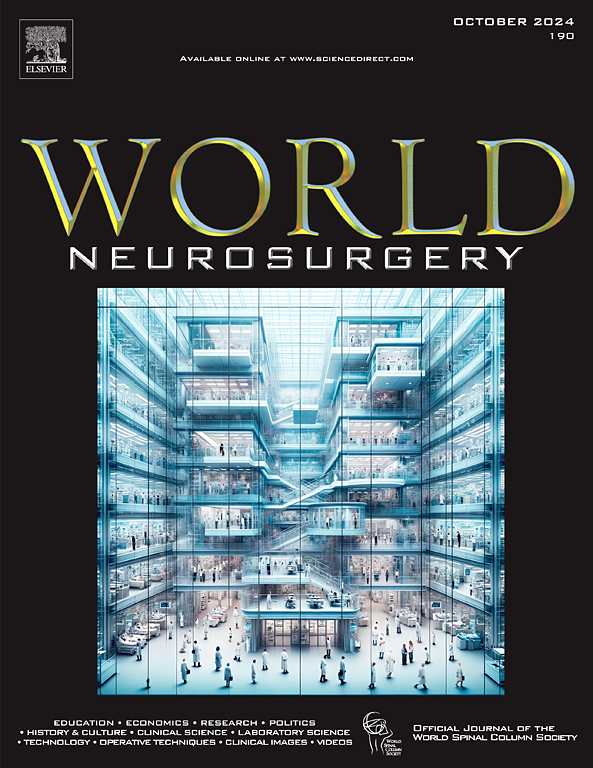Craniosynostosis in Africa: Insights from 8 Countries—A Systematic Review and Meta-Analysis
IF 1.9
4区 医学
Q3 CLINICAL NEUROLOGY
引用次数: 0
Abstract
Objective
Craniosynostosis is a congenital skull deformity that impacts development and quality of life of children if left untreated. This study aimed to evaluate literature regarding presentation, treatment, and outcomes of craniosynostosis in Africa.
Methods
A systematic review of the literature using PubMed/MEDLINE, Scopus, Web of Science, and Google Scholar databases was conducted according to the Preferred Reporting Items for Systematic Reviews and Meta-Analyses guidelines.
Results
Fourteen retrospective/prospective studies with 620 patients and 14 case reports involving 27 cases (8 countries) were included. In 12 articles, 56.6% of patients (317/560) were males, with a mean age of 2.4 years (confidence interval [CI]: 1.1–3.7). Abnormal head shape was the most reported presentation in 77.8% of cases (332/427, 8 articles). Syndromic craniosynostosis was seen in 25.2% (CI: 13.7%–36.6%). Common phenotypes were trigonocephaly in 31.5% (CI: 3.6%–59.4%), anterior plagiocephaly in 23.2% (CI: 5.1%–41.3%), and scaphocephaly in 22.1% (CI: 13.5%–30.8%). Five hundred seventy eight patients, 99.5% (CI: 99.0%–100.0%), underwent surgical treatment. Vault remodeling was performed in 72.9% patients (CI: 47.4%–98.6%). Postoperative complications included cerebrospinal fluid leaks 5.4% (CI: 0.0%–11.6%) and surgical site infections 4.5% (CI: 0.0%–10.8%). Follow-up ranged between 0.2 and 40.9 months; 95.6% of cases (CI: 90.1%–100.0%) exhibited improved deformity and neurological deficits at last follow-up. The mortality rate was 3.1% (CI: 0.0%–6.9%, 2 articles).
Conclusions
Few studies on craniosynostosis in Africa highlight the need for more research. Treatment with open techniques yields few complications and a low mortality rate. Early diagnosis and collaborative data reporting will enhance understanding of its burden and variations across Africa.
非洲颅缝闭合:来自八个国家的见解——一项系统回顾和荟萃分析。
目的:颅缝闭锁是一种先天性颅骨畸形,如果不及时治疗,会影响儿童的发育和生活质量。本研究旨在评估有关非洲颅缝闭锁的表现、治疗和结果的文献。方法:采用PubMed/MEDLINE、SCOPUS、Web of Science和b谷歌Scholar数据库,按照PRISMA (Preferred Reporting Items for systematic Reviews and meta - analysis)指南对相关文献进行系统综述。结果:纳入14项回顾性/前瞻性研究,涉及620例患者和14例病例报告,涉及27例(8个国家)。在12篇文章中,56.6%的患者(317/560)为男性,平均年龄为2.4岁(CI: 1.1-3.7)。77.8%的病例报告头部形状异常(332/ 427,8篇)。常见的表型为三角头畸形31.5% (CI: 3.6% ~ 59.4%),前斜头畸形23.2% (CI: 5.1% ~ 41.3%),尾形头畸形22.1% (CI: 13.5% ~ 30.8%)。578例患者,99.5% (CI: 99.0%-100.0%)接受手术治疗。72.9%的患者进行了拱顶重塑(CI: 47.4%-98.6%)。术后并发症包括脑脊液渗漏5.4% (CI: 0.0%-11.6%)和手术部位感染4.5% (CI: 0.0%-10.8%)。随访时间为0.2 ~ 40.9个月,95.6% (CI: 90.1% ~ 100.0%)的病例在最后一次随访中表现出畸形和神经功能缺损的改善。死亡率为3.1% (CI: 0.0%-6.9%, 2篇文章)。结论:在非洲很少有关于颅缝闭合的研究,这表明需要进行更多的研究。开放技术治疗并发症少,死亡率低。早期诊断和协作数据报告将加强对非洲各地疾病负担和变化的了解。
本文章由计算机程序翻译,如有差异,请以英文原文为准。
求助全文
约1分钟内获得全文
求助全文
来源期刊

World neurosurgery
CLINICAL NEUROLOGY-SURGERY
CiteScore
3.90
自引率
15.00%
发文量
1765
审稿时长
47 days
期刊介绍:
World Neurosurgery has an open access mirror journal World Neurosurgery: X, sharing the same aims and scope, editorial team, submission system and rigorous peer review.
The journal''s mission is to:
-To provide a first-class international forum and a 2-way conduit for dialogue that is relevant to neurosurgeons and providers who care for neurosurgery patients. The categories of the exchanged information include clinical and basic science, as well as global information that provide social, political, educational, economic, cultural or societal insights and knowledge that are of significance and relevance to worldwide neurosurgery patient care.
-To act as a primary intellectual catalyst for the stimulation of creativity, the creation of new knowledge, and the enhancement of quality neurosurgical care worldwide.
-To provide a forum for communication that enriches the lives of all neurosurgeons and their colleagues; and, in so doing, enriches the lives of their patients.
Topics to be addressed in World Neurosurgery include: EDUCATION, ECONOMICS, RESEARCH, POLITICS, HISTORY, CULTURE, CLINICAL SCIENCE, LABORATORY SCIENCE, TECHNOLOGY, OPERATIVE TECHNIQUES, CLINICAL IMAGES, VIDEOS
 求助内容:
求助内容: 应助结果提醒方式:
应助结果提醒方式:


